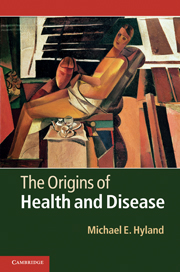Book contents
- Frontmatter
- Contents
- List of figures
- List of tables
- List of boxes
- Acknowledgements
- 1 The two philosophies: health, disease, medicine and psychotherapy
- 2 The body's mind: psychoneuroimmunology, stress and adaptive response
- 3 Personality, disease and the meaning of infornet dysregulation
- 4 Networks and their properties
- 5 The causes of dysregulation: associative learning, food intolerance and the effects of stress throughout the lifespan
- 6 The causes of dysregulation: supervised learning, repetitive strain injury, attention-deficit/hyperactivity disorder, chronic fatigue syndrome and depression
- 7 The causes of dysregulation: asthma and precursors to specific disease
- 8 Three different types of psychologically mediated therapy: placebos and the art of medicine, psychotherapy and complementary and alternative medicine
- 9 Therapeutic mechanisms
- 10 Finding the pattern: health in modern society
- 11 Infornet theory in perspective
- References
- Index
5 - The causes of dysregulation: associative learning, food intolerance and the effects of stress throughout the lifespan
Published online by Cambridge University Press: 05 June 2012
- Frontmatter
- Contents
- List of figures
- List of tables
- List of boxes
- Acknowledgements
- 1 The two philosophies: health, disease, medicine and psychotherapy
- 2 The body's mind: psychoneuroimmunology, stress and adaptive response
- 3 Personality, disease and the meaning of infornet dysregulation
- 4 Networks and their properties
- 5 The causes of dysregulation: associative learning, food intolerance and the effects of stress throughout the lifespan
- 6 The causes of dysregulation: supervised learning, repetitive strain injury, attention-deficit/hyperactivity disorder, chronic fatigue syndrome and depression
- 7 The causes of dysregulation: asthma and precursors to specific disease
- 8 Three different types of psychologically mediated therapy: placebos and the art of medicine, psychotherapy and complementary and alternative medicine
- 9 Therapeutic mechanisms
- 10 Finding the pattern: health in modern society
- 11 Infornet theory in perspective
- References
- Index
Summary
Introduction
This chapter brings together two ideas that were developed in previous chapters. The first of these is that of dysregulation. When the infornet is dysregulated it produces an inappropriate output to the inputs from the current situation. The second idea is that of learning in networks. There are two types of learning rule that are relevant to the infornet: associative learning and supervised learning. This chapter focuses on the origin of health and disease from the perspective of associative learning. The impact of supervised learning is discussed in the next chapter.
Here is a brief summary of some of the points made in earlier chapters. It is a requirement of living organisms that they constantly self-organise to achieve better self-regulation (see Chapter 1). Self-organisation is achieved through the application of network learning rules (Chapter 4). Under certain circumstances these self-organisational rules lead to poorer self-regulation, i.e., infornet dysregulation (Chapters 2 and 3). Infornet dysregulation can be defined as follows:
Infornet dysregulation occurs due to experiences that affect the learning rules of the infornet. These patterns of living lead to self-organisation change which, under normal circumstances is adaptive, but which due to the particular experience is maladaptive
Associative learning
Associative learning is based on a simple network learning rule. The rule is to strengthen the connection between units of a network that are simultaneously activated (Chapter 4). The consequence of this rule is that events that are contiguous in time tend to become associated.
- Type
- Chapter
- Information
- The Origins of Health and Disease , pp. 147 - 161Publisher: Cambridge University PressPrint publication year: 2011

